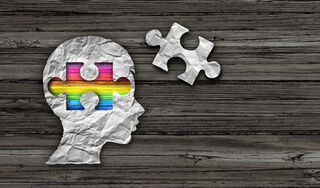Autism
Autism Spectrum Disorder: Uncovering a Hidden Internal World
New research reveals hidden biology underlying common behavioral problems.
Posted November 7, 2020 Reviewed by Devon Frye
By Megan Rech, Danna Ramirez, Cameron Johnson, Anika Wiltgen Blanchard, and Michelle Patriquin
“Much of our time in the broader world is lived with a certain amount of fear. Day-to-day life in a world built for neurotypical people can be like walking in a minefield. There are a lot of social rules that we don’t understand, and tremendous consequences inflicted on us for violating them.” —Ari Ne’eman, First Presidential Appointee with Autism
Autism Spectrum Disorder (ASD), a neurodevelopmental disorder affecting 1 in 40 children in the United States, is most often characterized by deficits in social communication and a restricted range of behavior and interests—both observable characteristics. Yet, recent advances in research have expanded our understanding by shedding light on the hidden biological mechanisms underlying the symptoms we observe. In fact, to learn more about autism’s more visible aspects—and ultimately better support those affected—many scientists are turning to forces at work beneath the surface.

Studies have shown that individuals with ASD can get stuck in a heightened state of high heart rate, low heart rate variability, and low respiratory sinus arrhythmia, with important implications for behavior. It appears that among those with ASD, greater baseline physiological activation correlates with greater emotion regulation challenges and behavioral difficulties, while less baseline physiological activation correlates with fewer problems and greater pro-sociality.
One potential explanation for these relationships has to do with the connection between physiological flexibility and emotional/behavioral flexibility. Some researchers propose that low biological flexibility—constantly being on high alert regardless of circumstance, without the ability to switch to a calmer state—may be linked to low cognitive-behavioral flexibility—referring to black-and-white thinking, difficulties with transition, and compulsive behaviors.
It turns out that understanding ASD through this lens can help explain several additional characteristics. For example, a recent study has shown that restricted and repetitive behaviors (RRBs) such as rocking and hand-flapping have an effect on cardiovascular activity. Specifically, it was found that RRBs were most likely to occur immediately following an increase in heart rate, and immediately before a decrease in heart rate, suggesting that such behaviors serve a calming, regulatory function.
Challenges with social reciprocity (the back-and-forth mutual exchange that takes place when people communicate) may relate to physiological state. The foundation for social reciprocity is physiological linkage—the synchronization of physiological states between interacting individuals—as it helps enable abilities such as attachment, attunement, and empathy. Research has shown that individuals with ASD do not show physiological linkages with their typically developing peers, suggesting difficulty adapting to others’ physiology, which may impact the development of supportive relationships.
Emerging evidence reveals that biological differences among those with ASD mirrors their external behaviors and influence their social relationships and cognitive functioning. This deeper understanding of biological differences can help inform efforts to support, include, help, accommodate, and celebrate those with ASD.
In thinking about accommodations for those with ASD, it is important to design ASD-friendly physical and social environments with these biological states in mind. For example, the Organization for Autism Research recommends that teachers and administrators consider factors that create less threatening social environments for people with ASD. In the classroom, it is particularly important to create positive interactions with peers by encouraging student engagement within the comfort level of the affected child (e.g., circle of friends, peer buddies) to prevent social isolation. With permission from the affected child’s parents, age-appropriate education on ASD (e.g., In My Mind) for their peers along with direct immersion increases the likelihood of acceptance and may make it easier for the child with an ASD to meet social goals.
Design and layout considerations of rooms could reduce this biologically heightened state and subsequently increase social engagement as well. Excessive noise can often be a complaint of those who have ASD, so taking measures like properly soundproofing adjacent rooms, installing acoustical carpet flooring, and eliminating regular internal sounds (e.g., clocks ticking, noisy appliances) can help make the space more ASD-friendly. This is not an exhaustive list of factors, but the linked graphic contains some ideas about how to make their environment more conducive for engagement. Many of these suggestions are based on collections of recommendations entailed in anecdotal experiences, which highlights a significant theme. However, there is no one size fits all accommodation, because of the heterogeneity in the ASD community.
Despite the internal and external differences that individuals with ASD can experience and demonstrate, they have unique strengths that can add tremendous value to our world. When asked about the skills their children with ASD possess, parents highlighted creative skill, intelligence, and physical capabilities. Many individuals with ASD have what Dr. Temple Grandin refers to as a “specialist mind” with learning styles; they are motivated to learn about specific subjects and can develop expert knowledge in their given areas. Moreover, their pursuit of these specific interests and enhanced perceptual capacities can lead them to excel in environments where concentration and information processing are needed.
Dr. Temple Grandin said it best: “The world is going to need all the different kinds of minds to work together. We’ve got to work on developing all these different kinds of minds.” By embracing the skills and interests that people with ASD bring, we will expand not only our personal ways of thinking but our society’s potential.
If you’re interested in learning more about autism, join us for New Advances in the Conceptualization and Treatment of Autism Spectrum Disorder, a webinar for mental health professionals that I’ll be presenting November 10 at 12 pm CT. Continuing education credits will be available.
About the Authors
Megan Rech serves as the research coordinator for Menninger's Adolescent Treatment Program. She is a graduate of Rice University, where she majored in Psychology and minored in biochemistry and cell biology.
Danna Ramirez is a clinical research informatics engineer at The Menninger Clinic. She graduated from Baylor University with a Bachelor of Science in Neuroscience and Forensic Sciences.
Cameron Johnson is a research assistant at The Menninger Clinic. He earned a bachelor's degree in Psychology from Rice University in Houston.
Anika Wiltgen Blanchard is a research interviewer at The Menninger Clinic with more than eight years of research experience and four years of counseling experience.
Michelle Patriquin, Ph.D., ABPP is director of Research and assistant professor in the Department of Psychiatry & Behavioral Sciences at Baylor College of Medicine.




